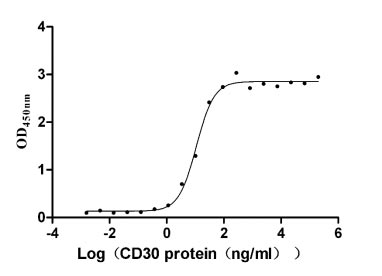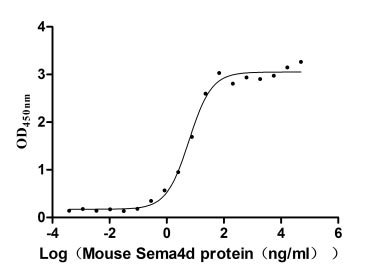Recombinant Human STE20/SPS1-related proline-alanine-rich protein kinase (STK39)
-
货号:CSB-YP883375HU
-
规格:
-
来源:Yeast
-
其他:
-
货号:CSB-EP883375HU
-
规格:
-
来源:E.coli
-
其他:
-
货号:CSB-EP883375HU-B
-
规格:
-
来源:E.coli
-
共轭:Avi-tag Biotinylated
E. coli biotin ligase (BirA) is highly specific in covalently attaching biotin to the 15 amino acid AviTag peptide. This recombinant protein was biotinylated in vivo by AviTag-BirA technology, which method is BriA catalyzes amide linkage between the biotin and the specific lysine of the AviTag.
-
其他:
-
货号:CSB-BP883375HU
-
规格:
-
来源:Baculovirus
-
其他:
-
货号:CSB-MP883375HU
-
规格:
-
来源:Mammalian cell
-
其他:
产品详情
-
纯度:>85% (SDS-PAGE)
-
基因名:STK39
-
Uniprot No.:
-
别名:DCHT; DKFZp686K05124; OTTHUMP00000165175; PASK; Proline alanine rich STE20 related kinase; Serine threonine kinase 39 (STE20/SPS1 homolog yeast); Serine threonine kinase 39; Serine/threonine protein kinase 39; Serine/threonine-protein kinase 39; Small intestine SPAK like kinase; SPAK; Ste 20 related kinase; Ste-20-related kinase; Ste20 like protein kinase; STE20/SPS1 homolog; STE20/SPS1 related proline alanine rich protein kinase; STE20/SPS1-related proline-alanine-rich protein kinase; STK 39; Stk39; STK39_HUMAN
-
种属:Homo sapiens (Human)
-
蛋白长度:full length protein
-
表达区域:1-545
-
氨基酸序列MAEPSGSPVH VQLPQQAAPV TAAAAAAPAA ATAAPAPAAP AAPAPAPAPA AQAVGWPICR DAYELQEVIG SGATAVVQAA LCKPRQERVA IKRINLEKCQ TSMDELLKEI QAMSQCSHPN VVTYYTSFVV KDELWLVMKL LSGGSMLDII KYIVNRGEHK NGVLEEAIIA TILKEVLEGL DYLHRNGQIH RDLKAGNILL GEDGSVQIAD FGVSAFLATG GDVTRNKVRK TFVGTPCWMA PEVMEQVRGY DFKADMWSFG ITAIELATGA APYHKYPPMK VLMLTLQNDP PTLETGVEDK EMMKKYGKSF RKLLSLCLQK DPSKRPTAAE LLKCKFFQKA KNREYLIEKL LTRTPDIAQR AKKVRRVPGS SGHLHKTEDG DWEWSDDEMD EKSEEGKAAF SQEKSRRVKE ENPEIAVSAS TIPEQIQSLS VHDSQGPPNA NEDYREASSC AVNLVLRLRN SRKELNDIRF EFTPGRDTAD GVSQELFSAG LVDGHDVVIV AANLQKIVDD PKALKTLTFK LASGCDGSEI PDEVKLIGFA QLSVS
-
蛋白标签:Tag type will be determined during the manufacturing process.
The tag type will be determined during production process. If you have specified tag type, please tell us and we will develop the specified tag preferentially. -
产品提供形式:Lyophilized powder
Note: We will preferentially ship the format that we have in stock, however, if you have any special requirement for the format, please remark your requirement when placing the order, we will prepare according to your demand. -
复溶:We recommend that this vial be briefly centrifuged prior to opening to bring the contents to the bottom. Please reconstitute protein in deionized sterile water to a concentration of 0.1-1.0 mg/mL.We recommend to add 5-50% of glycerol (final concentration) and aliquot for long-term storage at -20℃/-80℃. Our default final concentration of glycerol is 50%. Customers could use it as reference.
-
储存条件:Store at -20°C/-80°C upon receipt, aliquoting is necessary for mutiple use. Avoid repeated freeze-thaw cycles.
-
保质期:The shelf life is related to many factors, storage state, buffer ingredients, storage temperature and the stability of the protein itself.
Generally, the shelf life of liquid form is 6 months at -20°C/-80°C. The shelf life of lyophilized form is 12 months at -20°C/-80°C. -
货期:Delivery time may differ from different purchasing way or location, please kindly consult your local distributors for specific delivery time.Note: All of our proteins are default shipped with normal blue ice packs, if you request to ship with dry ice, please communicate with us in advance and extra fees will be charged.
-
注意事项:Repeated freezing and thawing is not recommended. Store working aliquots at 4°C for up to one week.
-
Datasheet :Please contact us to get it.
相关产品
靶点详情
-
功能:May act as a mediator of stress-activated signals. Mediates the inhibition of SLC4A4, SLC26A6 as well as CFTR activities by the WNK scaffolds, probably through phosphorylation. Phosphorylates RELT.
-
基因功能参考文献:
- SNP rs1468326 of WNK1, rs6749447 of STK39, and WNK1 haplotype AGACAGGAATCGT were associated with hypertension in Tibetan individuals PMID: 28945285
- STK39 polymorphisms are not associated with Parkinson's disease, ALS and multiple system atrophy in Chinese population. PMID: 29564728
- the polycomb repressor complex is essential for EBNA3A-mediated repression of STK39 Findings in this study provide new insights into the regulation of cellular genes by the transcription factor EBNA3A. PMID: 29367247
- STK39 acts as a tumor oncogene in non-small cell type lung cancer and can be a potential biomarker of carcinogenesis. PMID: 27542260
- In conclusion, these meta-analytical findings suggest that STK39 might not be a hypertension-susceptibility gene. PMID: 27142475
- Here, we report our replication data showing a significant association of the rs3754777 polymorphism, but not rs35929607, of STK39 with essential hypertension in a male Chinese Han population. PMID: 26911228
- did not observe any significant difference in allele and genotype distribution between Parkinson's disease patients and controls for rs1955337 in STK39 PMID: 26914237
- Single nucleotide polymorphisms STK39 and WNK1 were associated with hypertension and BP in our multicenter Belgian case-control study PMID: 27082544
- STK39 mRNA and protein express abnormally in primary hypertension patients with genetic variation, which is related to the blood pressure. PMID: 26662444
- SPAK protein has both the potential to up-regulate KCNQ1/E1 protein abundance in the cell membrane, an effect possibly participating in the regulation of cell volume, excitability, epithelial transport and metabolism. PMID: 26584301
- These observations establish that the CCT domain plays a crucial role in controlling SPAK activity and BP. PMID: 25994507
- Findings indicate that the serine threonine kinase 39 (STK39) mRNA expression is increased in rs3754777 knockin cell lines. PMID: 26416847
- These findings suggested that the STK39 rs1955337 TT genotype is a risk factor for Han-Chinese patients with PD in Taiwan PMID: 26469904
- Taken together, our findings suggest the potential interactive role of STK39 gene multiple polymorphisms in the development of hypertension among northeastern Han Chinese. PMID: 24873805
- In Chinese children, no association of CSK rs1378942, MTHFR rs1801133, CYP17A1 rs1004467, STK39 rs3754777 and FGF5 rs16998073 with BP/risk of hypertension. PMID: 23759979
- SPAK short forms in the kidney are created by aspartyl aminopeptidase (Dnpep)-mediated proteolytic cleavage PMID: 25164821
- the association of the loci rs11711441 near STK39 and sporadic Parkinson disease in the Chinese Han population is confirmed PMID: 24631562
- STK39 (rs2102808) and CCDC62/HIP1R (rs12817488) do not appear to influence PD risk. PMID: 24312176
- SPAK isoforms both inhibit NKCC1 and NKCC2 activity (cation cotransporter)that may be important in renal physiology. PMID: 24133122
- A significant association between STK39 genetic variant rs6749447 and hypertension was found in a Finnish cohort. PMID: 23235358
- Essential hypertension risk conferred by STK39 rs35929607 polymorphism *A/G) was different from that previously reported in a European population. PMID: 23894895
- study found no evidence that STK39 was associated with hypertension in the Chinese population PMID: 23151749
- The present meta-analysis confirms the significant association of STK39 polymorphism with susceptibility to hypertension in Europeans and East Asians. PMID: 23527223
- SPAK and OSR1, which are oftencoexpressed in cells can form functional heterodimers. PMID: 23034389
- STK39 is an independent risk factor for hypertension in men and its intragenic single nucleotide polymorphisms can interact and function in the control of blood pressure. PMID: 20889219
- our results suggest no significant assocation between any of the core autism symptom domains or the four additional previously identified familial features and the rs1807984 SNP on the STK39 gene. PMID: 21442361
- SPAK increases intestinal epithelial permeability; both SPAK-transfected Caco2-cells and SPAK transgenic mice exhibit loss of intestinal barrier function and homeostasis in inflammatory bowel disease. PMID: 21705622
- Serine/threonine kinase 39 is a candidate gene for primary hypertension especially in women. PMID: 21178783
- phosphorylation-induced activation of NKCC1 by osmotic shrinkage does not involve AMP-activated protein kinase and is likely to be due to STE20/SPS1-related proline/alanine-rich kinase activation PMID: 20442269
- STK39 expression is modified by polymorphisms acting in cis and the typed SNPs are associated with allelic expression of this gene, but there is no evidence for an association with blood pressure in a British Caucasian cohort PMID: 20003416
- roles in phosphorylation and activation of the Na-K-Cl cotransporter (NKCC1) PMID: 12740379
- TNF-related apoptosis-inducing ligand down-regulation of SPAK is an important event that enhances its apoptotic effects PMID: 16950202
- evidence for linkage and association between autism and loci within the 2q24-q33 region, including at STK39 PMID: 18348195
- PKCdelta acts upstream of SPAK to increase activity of NKCC1 during hyperosmotic stress PMID: 18550547
- During inflammatory conditions, TNF-alpha is a key regulator of SPAK expression. PMID: 18787102
- variants in STK39 may influence blood pressure by increasing STK39 expression and consequently altering renal Na(+) excretion PMID: 19114657
- data suggest that SPAK, the transcription of which is regulated by hyperosmolarity, plays an important role in epithelial barrier function PMID: 19343169
- Brain WNK3 acts in tandem with SPAK, whereas renal WNK3 seems to upregulate NCCT through a SPAK-independent pathway. PMID: 19470686
- SPAK loss in B-cell lymphomas promotes increased cell survival with DNA damage and provides a potential mechanism for increased resistance to genotoxic stress in cancer. PMID: 19717643
显示更多
收起更多
-
亚细胞定位:Cytoplasm. Nucleus.
-
蛋白家族:Protein kinase superfamily, STE Ser/Thr protein kinase family, STE20 subfamily
-
组织特异性:Predominantly expressed in brain and pancreas followed by heart, lung, kidney, skeletal muscle, liver, placenta and testis.
-
数据库链接:
HGNC: 17717
OMIM: 607648
KEGG: hsa:27347
STRING: 9606.ENSP00000348278
UniGene: Hs.276271
Most popular with customers
-
Recombinant Human 5'-nucleotidase (NT5E) (Active)
Express system: Mammalian cell
Species: Homo sapiens (Human)
-
Recombinant Human Tumor necrosis factor ligand superfamily member 8 (TNFSF8), partial (Active)
Express system: Mammalian cell
Species: Homo sapiens (Human)
-
Recombinant Mouse Semaphorin-4D (Sema4d), partial (Active)
Express system: Mammalian cell
Species: Mus musculus (Mouse)
-
Recombinant Human HLA class II histocompatibility antigen gamma chain (CD74), partial (Active)
Express system: Mammalian cell
Species: Homo sapiens (Human)
-
Recombinant Human Claudin-9 (CLDN9)-VLPs (Active)
Express system: Mammalian cell
Species: Homo sapiens (Human)
-
Recombinant Mouse Cell adhesion molecule 1 (Cadm1), partial (Active)
Express system: Mammalian cell
Species: Mus musculus (Mouse)
-
Recombinant Human Cell adhesion molecule 1 (CADM1), partial (Active)
Express system: Mammalian cell
Species: Homo sapiens (Human)
-
Recombinant Human Killer cell immunoglobulin-like receptor 3DL2 (KIR3DL2), partial (Active)
Express system: Mammalian cell
Species: Homo sapiens (Human)





-AC1.jpg)














